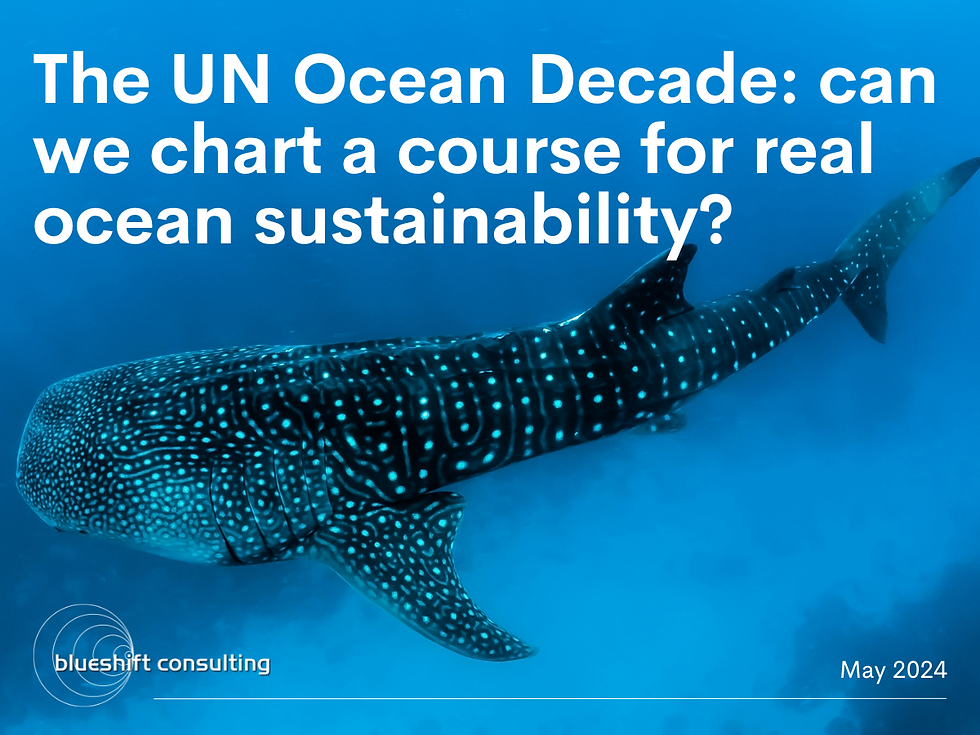Exploring Environmental Credit Pathways for Seaweed Aquaculture
- Olivia Smailes

- May 16
- 4 min read
Over the past few years, seaweed farming in Australia has gained momentum, particularly around the red seaweed Asparagopsis, known for its ability to reduce methane emissions in cattle. But beyond feed supplements, there’s growing interest in whether seaweed aquaculture could support environmental markets through the generation of credits for carbon, nutrient removal and biodiversity.
A new report, led by Blueshift and funded by the Fisheries Research Development Corportation (ASSA) in partnership with the Australian Sustainable Seaweed Alliance (ASSA), takes a close look at this potential. It brings together literature, market analysis, and stakeholder insights to better understand where seaweed fits in the evolving landscape of environmental credits, and what needs to happen next.
Potential Pathways to Generating Environmental Credits Through Seaweed Aquaculture
The report maps out three main pathways for generating credits from seaweed cultivation: carbon, nutrient, and biodiversity.
Carbon credits are perhaps the most discussed, especially in relation to Asparagopsis. When used as a livestock feed additive, it can significantly reduce methane emissions from cattle. This has clear abatement potential, but whether and how it translates into a credit depends on the development of appropriate methodologies and life cycle accounting.
Other potential pathways include converting seaweed into long-lived products like biochar, or capturing waste CO₂ in onshore seaweed systems. Concepts like deep-sea burial of harvested seaweed are also explored in the literature, though this approach is unlikely to meet the permanence and accountability standards required by current carbon market rules.
While promising, the carbon space remains difficult for seaweed to enter at scale, largely due to measurement challenges and the lack of seaweed-specific methods recognised under major credit schemes.
Nutrient credits, on the other hand, may offer a more immediate opportunity. Seaweeds take up nitrogen and phosphorus as they grow, and this nutrient removal can help treat wastewater and reduce pollution in coastal environments and waterways. In Northern Australia, microalgae is being applied as a bioremediation tool in municipal waste treatment through PacificBio's RegenAqua technology. In 2023, RegenAquaTM received approval as a methodology under the Reef Credits scheme. As an approved methodology, users of the technology can be rewarded by the sale of Reef Credits, a type of credit which represents a tradable unit of pollution reduction.
The third area is biodiversity. Seaweed farms can create habitat, increase species richness, and support local food webs. In some cases, they can help restore degraded ecosystems by improving oxygen levels and reducing eutrophication. But unlike carbon or nutrient reduction, biodiversity gains are harder to quantify. There’s no single accepted unit of measurement, and credit markets for biodiversity are still emerging. Until clearer frameworks are in place, this will remain a longer-term prospect.
Relative Viability
Looking across the three types, nutrient credits currently offer the most practical and achievable entry point for the seaweed industry. The ecological benefits are well recognised, and nutrient removal is comparatively straightforward to measure. Frameworks like Queensland’s Reef Credit Scheme already provide a foundation that could be extended to include marine macroalgae.
Carbon credits, by contrast, face more significant hurdles. While there is strong interest in the role of Asparagopsis as a methane-reducing feed additive, the process of translating this benefit into a verifiable, tradeable credit is technically and administratively complex. There are unresolved questions around life cycle emissions, allocation of abatement across the supply chain, and the development of appropriate methodologies. In addition, the broader credibility of carbon markets is under scrutiny, and the price of blue carbon remains too low to justify investment at the farm level. For these reasons, carbon crediting is unlikely to be a viable pathway for most seaweed producers in the near term.
Biodiversity crediting remains the most nascent of the three. While seaweed farms can provide habitat and support local ecosystems, the absence of standardised metrics makes it difficult to quantify these benefits in a way that meets market or regulatory requirements. Nonetheless, biodiversity enhancement may still form part of a broader value proposition, especially in integrated or multi-benefit projects.
Industry Feedback
As part of the project, Blueshift conducted structured interviews with 25 seaweed industry members both in Australia and overseas. Most were aware of environmental markets and optimistic about their relevance, but unsure about how to engage with them in practice. Key themes included the need for:
clearer guidance on how credits might apply to seaweed operations,
simplified regulation and licensing processes,
support for upfront costs related to credit generation, and
more clarity around market demand and pricing.
Many highlighted that without some form of government support, be it method development, pilot projects, or financial incentives, entry into environmental markets would remain out of reach for most producers.
Policy Position and Recommendations
To support the sector’s future participation in environmental credit markets, the report presents a policy position developed for the Australian Sustainable Seaweed Alliance (ASSA). This position outlines clear and actionable priorities that, if adopted, could help build the regulatory and technical foundations needed for seaweed-derived credits to be recognised and traded.
Key recommendations include:
Formal recognition of seaweed within national environmental market frameworks, such as the Emissions Reduction Fund and the Nature Repair Market. This would provide a pathway for producers to access carbon, nutrient, and biodiversity credit schemes.
Development of seaweed-specific credit methodologies, particularly for nutrient uptake and emissions abatement (e.g. via Asparagopsis feed additives), with a strong emphasis on improving measurement, reporting, and verification.
Reform of aquaculture regulations to reduce barriers to entry and support the sector to scale. This includes more consistent approval processes across jurisdictions and formal recognition of seaweed within the National Aquaculture Strategy.
Support for Indigenous leadership and participation, ensuring Indigenous communities are included in the development of seaweed projects and benefit from market opportunities. This reflects both the cultural significance of sea country and the practical value of Indigenous knowledge in managing marine systems.






Comments